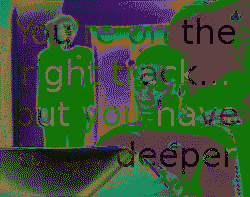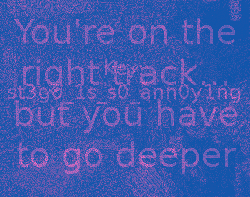We are a little unsure what the robots fascination with Star Trek is but it
would seem from the amount of accesses this image has been getting that it
holds something interesting for them. Can you figure out what it is?
http://i.imgur.com/MjYUJ.gif
stego is an animated image (GIF) made from a Star Trek sequence. The first task was to learn more about the GIF format. I used the spec itself. The main things to know are:
- Images are represented as an array of palette-based pixels;
- There is one global color palette and image frames can embed their own local palette;
- A GIF file contains a “stream” of sections: image frames, metadata sections, etc.
The first try was to decode completely the given file in order to check the sections against unusual metadata blocks (to maybe find embedded information) or hidden frames, but everything was just usual.
Then, I took a closer look to the palettes: no image frame had a local palette, so I just looked at the global palette, and I found something surprising: many palette entries had the same color! The consequence was that in some image frames, one could see an uniform area instead of different colors, hidding shapes in the same way the Ishihara test would for color deficient people.
To reveal these shapes, I replaced the whole palette using random colors in order to remove color “aliasing”. With an image editor, I could then see that the first frame displayed “You’re on the right track but you have to go deeper”. Meh.

As a next try, I still looked at palette-related issues (the given hint was
“Palette” after all!): are some palette colors over-used, or under-used?
Nothing raised from this search, and after some time, someone from the team
asked me “have you tried to xor all image frames together?”. Damn, I had not,
but could it be so simple… and so palette-unrelated?
Using a simple Python script, I tried to xor palette indexes for each image
frames and it gave me the previous text, plus Key: st3g0_is_s0_ann0y1ng.
